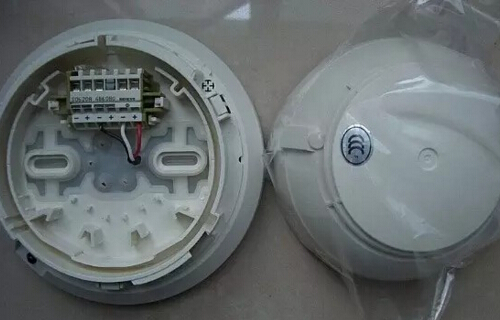Before we shared smart products commonly used in smart homes, such as smart door locks, electric curtains, and so on, let's share today's commonly used home fire detectors, such as smoke detectors, temperature detectors, and gas leak detectors. Today we first talk about smoke detectors.

First of all, the classification of smoke detectors is generally classified from the detection range to a bit type and a line type, and the point type is divided into ion smoke and photo-electricity smoke, and the linear type is divided into laser smoke and separated infrared beam smoke. Most of the smoke detectors suitable for our home use are photo-electric smoke detectors.
Photoelectric smoke detector works
Photoelectric smoke detectors are developed using the basic property that the smoke produced during a fire can change the propagation characteristics of light. When the smoke concentration reaches a certain degree, the photo-electric smoke detector emits an alarm signal. According to the absorption and scattering of light by smoke particles. Optical smoke detectors are classified into two types: light-blocking and astigmatism. According to the different access methods and battery power supply methods, it can be divided into a network-type smoke sense, an independent smoke sense, and a wireless smoke sense.

Networked smoke detectors are generally suitable for large-scale fire automatic alarm systems. To understand them simply, they need to be used together with the central control host. They cannot work independently, but only the front-end signal acquisition has no on-site output function.
Independent smoke detectors, generally suitable for home use, can collect alarm signals at the scene, and emit alarm sound and light at the scene. The installation is simple and easy to use.
Wireless smoke detectors are generally suitable for small home wireless alarm systems. They are used in conjunction with the central control host and use wireless communication with the control host.
The structure diagram of the photo-electric smoke detector is as follows. When smoke occurs during the initial stage of the fire, the smoke enters the smoke storage chamber and the sensor fails to receive the infrared light. The detector issues an alarm.

Photoelectric Smoke Detector Installation Notes:
1. The horizontal distance from the detector to the wall and the edge of the beam should not be less than 5 meters; there should be no obstruction within the horizontal distance of the detector within 0.5 meters.
2. The horizontal distance from the detector to the closest edge of the air-conditioning air outlet should not be less than 5 meters; the horizontal distance from the multi-hole air-supply top grid orifice should not be less than 0.5 meters.
3. Smoke detectors should not be installed in places with high concentrations of smoke and water vapor.
4, the detector should be installed horizontally, when you really need to tilt the installation, the tilt angle should not exceed 45 degrees.

First of all, the classification of smoke detectors is generally classified from the detection range to a bit type and a line type, and the point type is divided into ion smoke and photo-electricity smoke, and the linear type is divided into laser smoke and separated infrared beam smoke. Most of the smoke detectors suitable for our home use are photo-electric smoke detectors.
Photoelectric smoke detector works
Photoelectric smoke detectors are developed using the basic property that the smoke produced during a fire can change the propagation characteristics of light. When the smoke concentration reaches a certain degree, the photo-electric smoke detector emits an alarm signal. According to the absorption and scattering of light by smoke particles. Optical smoke detectors are classified into two types: light-blocking and astigmatism. According to the different access methods and battery power supply methods, it can be divided into a network-type smoke sense, an independent smoke sense, and a wireless smoke sense.

Networked smoke detectors are generally suitable for large-scale fire automatic alarm systems. To understand them simply, they need to be used together with the central control host. They cannot work independently, but only the front-end signal acquisition has no on-site output function.
Independent smoke detectors, generally suitable for home use, can collect alarm signals at the scene, and emit alarm sound and light at the scene. The installation is simple and easy to use.
Wireless smoke detectors are generally suitable for small home wireless alarm systems. They are used in conjunction with the central control host and use wireless communication with the control host.
The structure diagram of the photo-electric smoke detector is as follows. When smoke occurs during the initial stage of the fire, the smoke enters the smoke storage chamber and the sensor fails to receive the infrared light. The detector issues an alarm.

Photoelectric Smoke Detector Installation Notes:
1. The horizontal distance from the detector to the wall and the edge of the beam should not be less than 5 meters; there should be no obstruction within the horizontal distance of the detector within 0.5 meters.
2. The horizontal distance from the detector to the closest edge of the air-conditioning air outlet should not be less than 5 meters; the horizontal distance from the multi-hole air-supply top grid orifice should not be less than 0.5 meters.
3. Smoke detectors should not be installed in places with high concentrations of smoke and water vapor.
4, the detector should be installed horizontally, when you really need to tilt the installation, the tilt angle should not exceed 45 degrees.
Plant Essential Oils are volatile compounds that have been widely used in perfumery, aromatherapy, cosmetics, and for flavoring food and drink, and to a lesser extent, been used in food preservation, in medicine and household cleaning products.
Natural Borneol
Litsea Cubeba Oil
Alpha-Terpineol
Clove Oil
Eucalyptus Oil
Camphor Oil
Citronella Oil
Benzaldehyde
Benzyl benzoate
Hydroquinone
Dimethylbenzylcarbinyl butyrate


Plant Essential Oils
Plant Essential Oils,Litsea Cubeba Oil,Eucalyptus Oil,Camphor Oil,Citronella Oil
shijiazhuang yihe-chem co.,ltd , https://www.yihe-chem.com